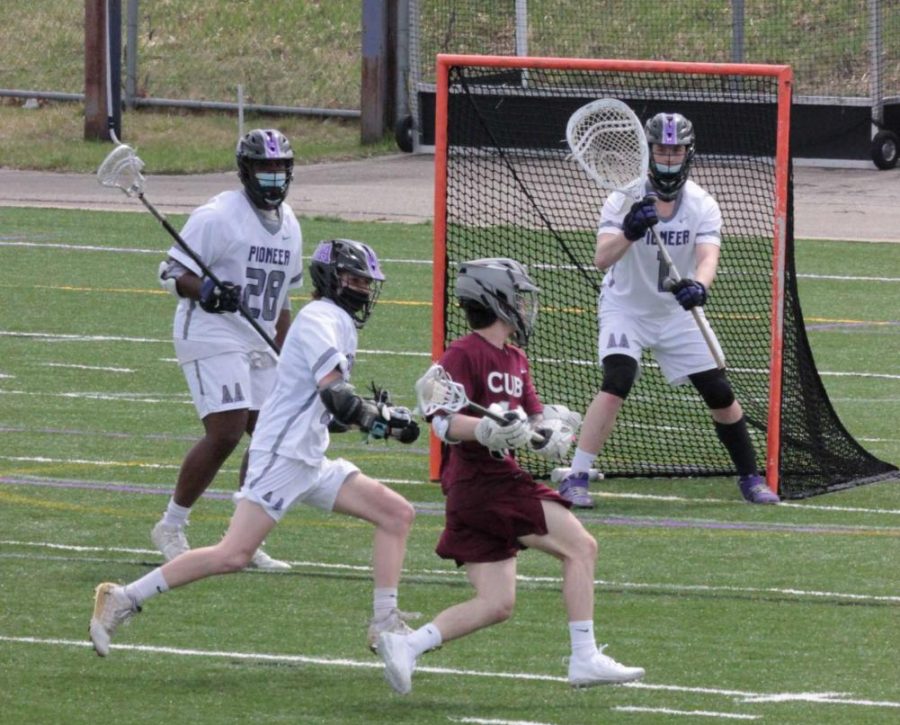Public vs. Private High School Athletics
James Dabrowski of Ann Arbor Pioneer High School scores a goal against U of D Jesuit High School and Academy in a Lacrosse match. The Pioneers won the game against the Cubs by a score of 10-5. “We came into the game not having beat U of D in 10 years,” Dabrowski said. “We had a positive mindset because we had a talented team.”
Eight months ago,The Detroit Catholic Central Wrestling team defeated the Macomb Dakota Wrestling team by a score of 56-14. With an enrollment just shy of 3,000, public high school Macomb Dakota is the largest high school in Michigan. On the other hand, Detroit Catholic Central, is the eighth-largest private high school in Michigan, with an enrollment of 1,025. This is not an uncommon theme. This pattern of private school domination is seen across a variety of sports.
Out of all the member schools in the MHSAA, Michigan High School Athletic Association, only 14% are private schools. Despite private institutions only making up a small percentage of competitors, they have won 30% of state championships across all sports since the year 2000, per the MHSAA website. In football, a typically well funded sport, 41% of all state titles across all divisions of Michigan high school football have been won by private schools. Newer data shows that the divide for football is increasing as well: since 2011, private schools have won 49% of the state titles across all divisions of football.
The MHSAA separates competition among schools using divisions, which are based on enrollment size. Each sport has around four to eight divisions depending on how many competing teams there are in that specific sport.So why is it that public high schools with enrollment numbers twice the size of their private school counterparts seem to have less success in athletics?
“I think recruiting plays a big role,” said Graeme Jagger, a junior on the lacrosse team at Greenhills School, a private college-prep school in Ann Arbor. “There’s definitely private schools that go out and recruit kids and have professionals come to help train with their teams. Those schools definitely do seem to have an advantage in that way.”
Jagger has been attending Greenhills since he began high school in the fall of 2019. He says he hasn’t seen his school exercise their ability to recruit for athletics.
“Although Greenhills doesn’t do any recruiting, we could easily have the ability to do so,” Jagger said. “It’s just our school is more academically focused than it is athletically. We play some private schools with a more casual team where just people play, just like us, that’s more evenly matched.”
Private schools can control who they choose to admit to their schools and whom they refuse admittance to. They can also offer scholarships and guarantee spots on teams to students in order to persuade them to choose their school. Under MHSAA laws, public schools cannot openly recruit kids to attend their schools. However, there is a rule that seems to level the playing field for public schools when it comes to recruiting.
The Michigan School of Choice rule, enacted in 1996 under the State School Aid Act, allows for more flexibility for students wanting to enroll at public schools that aren’t located within their district. The rule enables students to enroll at any school within their intermediate school district or any school in an intermediate school district bordering their own.
“School of Choice just makes it easier for kids to go to different schools,” said Matthew Dombrowski, a junior Track and Cross Country athlete for Ann Arbor Pioneer High School. “I don’t think it was meant to be used as a recruiting tool for public schools, but it just kind of ended up being something that can be used that way.”
Jagger doesn’t see a problem with schools using School of Choice for recruiting athletes.
“I don’t think ‘School of Choice’ and recruiting are always bad things,” He said. “Because if you’re one of the top players, you want to go play for the best schools. I think it comes down to what schools choose to use the ‘School of Choice rule’ within athletic recruitment.… It changes the competitive landscape and really makes it harder for schools who don’t recruit to compete at the same level [as those who do].”
In other states around the nation, states like New York, Maryland and Texas, have all established rules to reconstruct how the public and private high school competition is set up. These states hold their own separate playoffs for public and private schools. Another system used by states like Ohio, Illinois and Georgia, uses a multiplier to increase private schools’ enrollment numbers purely for placement in a new division for competition. For example, in Illinois, you would multiply the selected school’s enrollment number by 1.65, and then place it in its division based on that adjusted number.
Dombrowski doesn’t think it’s necessary to separate competition between public and private schools.
“There’s enough of those really good schools on each end of the public and private spectrum of it that it’s not really to the point where I would separate their competitions,” Dombrowski said. “I think there could be some adjustments made, but I don’t think their competition should be completely separated because there’s still a good amount of private and public schools that aren’t built to create a powerhouse… To completely separate them would disrupt some sports unevenly.”
Dombrowski speaks about how different schools hold different values when it comes to athletics. Jagger says his high school doesn’t put as much emphasis on creating a dominant sports program as other schools do.
“Our school doesn’t put all of our resources into creating a huge, dominant athletic program,” Jagger said. “I think it’s fine that schools do that because ‘Who doesn’t want to win? But at the end of the day you have to think about what high school sports are about. You have to ask yourself: what is the goal here?”











